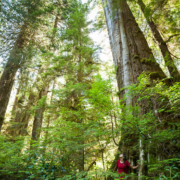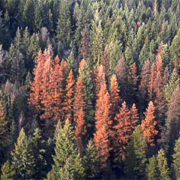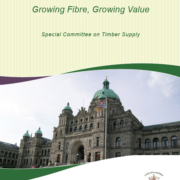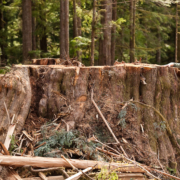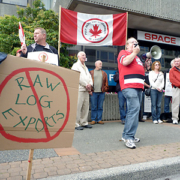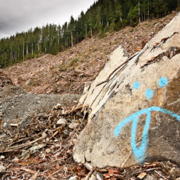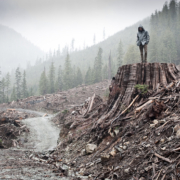For Immediate Release
August 15, 2012
Timber Committee Opens Back Door for Potential Logging of Protected Forest Reserves in BC’s Central Interior
Committee also recommends continued overcutting, logging of “marginal” stands (ie. slow growing subalpine forests) and creating more “area-based tenures” ie. increasing private property-like rights on public forest lands.
Today the Special Committee on Timber Supply released its report on how to deal with a timber shortfall in BC’s Central Interior in relation to the forest industry’s regional overcapacity. See the report here: https://www.leg.bc.ca/cmt/39thparl/session-4/timber/reports/PDF/Rpt-TIMBER-39-4-GrowingFibreGrowingValue-2012-08-15.pdf
Of greatest environmental concern was the committee’s recommendation to create local committees to review the possibility of opening up protected forest reserves for logging. These forest reserves include:
– Old-Growth Management Areas that currently protect old forests
– Wildlife Habitat Areas that protect species at risk
– Visual Quality Objectives that protect scenery for tourism
– Riparian Management Areas that protect water quality and fish habitat
– Ungulate Winter Range that protects the winter habitat of large herbivores like mountain caribou
– Recreation Areas for camping, hiking, outdoor activities
Recommendation 2.2 calls for the BC government to:
“Design a science-based review process for local use by monitoring committees in the assessment of existing sensitive-area designations to ascertain if they are still defensible or whether they need to be modified.”
“Instead of opening up protected forest reserves directly, which they know is highly unpopular with the public, they’re recommending a back door entry point for the logging industry into these currently protected forests. It’s based on the false notion that because there are many beetle-killed trees, that the entire ecosystem is not ‘living’ and therefore clearcutting and punching roads into vast swaths of protected forests – which are a mix of living and dead trees that are part of very vibrant, alive, and continually growing ecosystems – does little incremental damage. That’s just plain false and any ecosystem-based science review will show that,” stated Ken Wu, executive director of the Ancient Forest Alliance. “In particular, it looks like they’re recommending an expedited process for logging sensitive areas in the Burns Lake region, with other regions to follow.”
Pine beetle-affected forests include living, unaffected trees of various species, younger regenerating trees, and intact understory vegetation and soil structures, while the dead trees and woody debris provide homes for much wildlife. The extent of the pine beetle infestation is unnatural, caused by anthropogenic climate change and decades of wildfire suppression by the forest industry – however, further clearcutting of these living, dynamic forest ecosystems by removing all the living and dead trees and punching road networks throughout them, leading to soil erosion, vastly increases the environmental damage.
The potential environmental deregulation would take place in four Timber Supply Areas (TSA’s): the Prince George, Quesnel, Williams Lake, and Lakes (Burns Lake area) TSA’s.
“However, I should also point out that if the government does follow up on this recommendation, then it does open the door for the potential expansion of protected forest reserves if it is guided by a true ecosystem-based science framework. Such a science framework, particularly with the advancement of landscape ecology and conservation biology over the past two decades, would clearly reveal the inadequacy of the existing land-use plans and their system of protected forest reserves to stem the decline of species at risk, to sustain old-growth ecosystems, to support scenery for tourism, and to protect fish habitat. If anything, a true science-based review process would lead to an expansion of forest protections in the old land-use plan areas. But I wouldn’t count on the BC Liberal government, given the pressure by the massive timber lobby, to not create a rigged-game in the terms of reference and constraints placed on such a process,” notes Wu.
The Special Committee on Timber Supply, consisting of four BC Liberal MLA’s and three NDP MLA’s, held public hearings in rural communities in July in the Cariboo-Chilcotin region and met with stakeholders in Vancouver to gather input. Prior to the tour, Committee Chair John Rustad, BC Liberal MLA for Nechako Lakes, had spoken in the media several times with a heavy bias towards justifying logging in forest reserves and even suggested opening up Tweedsmuir Provincial Park for logging.
The rationale for opening up forest reserves is that an impending shortfall of available timber to support local sawmills will soon take effect, known as the “falldown effect”. This shortfall in timber in relation to an overcapacity in the forest industry is the result of the loss of mature forests from the pine beetle infestation (caused by climate change and forest fire suppression) and a massive industry expansion in the Interior in recent years to take advantage of the infestation.
Other destructive recommendations by the committee include:
– Expanded harvesting of “marginal” forest types (Recommendation 2.1), that is, in high elevation subalpine regions with slower growth rates and where regeneration after logging is slower. This will not only damage sensitive ecosystems, but will result in an expansion of Not Sufficiently Restocked (NSR) sites in the province.
– Expanding area-based tenures (Recommendation 5.1), as opposed to volume-based tenures and timber sales. Area-based tenures, ie. Tree Farm Licenses, ultimately limit the diversity of firms in the industry. Over time typically larger entities will acquire area-based tenures in areas with higher timber values, as the history of the province shows. While Community Forest Tenures can be progressive additions to BC’s system of forestry, most area-based tenures are a means towards corporate concentration in the industry. They also diminish the public’s ability to regulate such lands and to create new protected areas, as they confer more private-property type rights on technically public lands.
Instead of opening up protected forest reserves and ensuring more overcutting that will only exacerbate the future falldown, the AFA is calling for a forest and jobs transition strategy involving ending massive wood waste in clearcuts, incentives for value-added wood manufacturing industries, support and training for unemployed forestry workers, expanded protection of forests to sustain ecosystems and communities, and economic diversification of rural communities.
“More overcutting and opening up protected forest reserves to try to prop-up an unsustainable industry a bit longer is like burning parts of your house for firewood after depleting all other wood sources. In the end, you’re a lot worse off,” stated Wu. “Rewarding unsustainable behaviour with more unsustainable behavior is completely the wrong approach. The Interior timber industry’s unsustainable expansion and overcutting of beetle-affected wood and vast areas of living trees should not be rewarded with more of the same inside of our protected forest reserves – that’s the worst, most myopic course of action possible and it’s precisely the type of mindset that has brought this planet to the ecological brink.”

